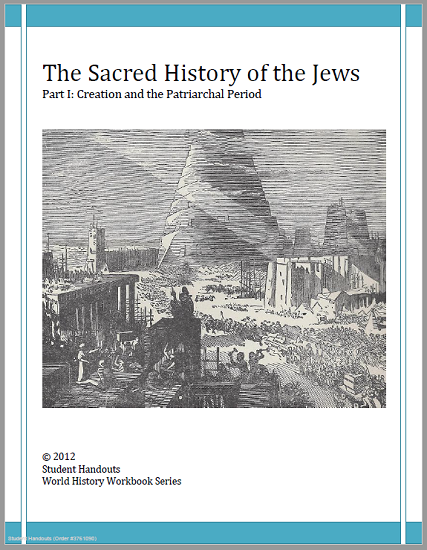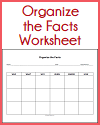| Sacred History of the Jews: Part I, Creation and the Patriarchal Period—History Workbook |
|---|
| www.studenthandouts.com ↣ World History ↣ Ancient Israel ↣ Ancient Israel Miscellany |
 |
   |
|
This student-friendly workbook is part of our World History Workbooks series. "Sacred History of the Jews: Part I - Creation and the Patriarchal Period" focuses on biblical (Judeo-Christian) accounts of the earth's formation, through the presence of Jews in Egypt at the death of Joseph (son of Jacob). From the workbook's introduction:
This workbook gives an overview of earliest Jewish history, covering the time period from the Judeo-Christian date for the world’s creation to the earliest time the ancient Jews spent in Egypt. This includes the patriarchal age, when the core beliefs and practices of Judaism crystallized. The term patriarch refers to the male leader of a family or tribe. Technically, Abraham is held to have been the first patriarch of the Jews, the other two being his son, Isaac, and grandson, Jacob. The text of this workbook combines knowledge from the historical and archaeological record as well as biblical accounts of events. Although adherents to Abrahamic religious faiths may find this booklet useful in religious instruction, it is not designed as a book to be used for the purpose of indoctrination or instruction. This workbook is principally aimed at those students raised within other ideological systems, and is designed to familiarize readers with the motifs, stories, and beliefs that permeate so much of western civilization's culture, history, art, and literature. Biblical dates for births and deaths are left unquestioned, while supplemental information is included where appropriate. Appropriate for learners ages 12 and up, the beauty of this workbook lies in its simplicity. Brief chunks of text are perforated with questions that range from basic recall, to critical thinking, to college-prep vocabulary. There are also numerous illustrations, familiarizing your child with both the context of the workbook's content as well as with the rich Western art traditions that draw on the Bible for inspiration. Our student workbooks provide learners the opportunity to learn independently. Parents or teachers introduce the topic, then give students the workbook to read and complete. After the workbook has been completed, students have acquired the necessary comprehensive content knowledge to competently discuss the topic with educators and others, and will be motivated to branch their study of the topic into other related lines of inquiry. Works great as a stand-alone item or as a supplement to a larger unit. Click here to print. The answer key is below. Answer Key: 1. C - 6; 2. B - Eve; 3. B - Asia; 4. Tree of Knowledge of Good and Evil; 5. Answers will vary; 6. Answers will vary; 7. C - Belief in one god; 8. A - gopher; 9. C - massive rainfall; 10. D - Utnapishtim; 11. B - Ararat; 12. dove; 13. Shem, Ham, and Japheth; 14. D - ziggurat; 15. Moses; 16. God told Abram to leave Ur and go into a land that God would show him; 17. D - trust; 18. Eliezer; 19. Abram didn’t want the king (pharaoh) to kill him in order to get Sarai; 20. C - Quarrels over livestock; 21. Chedorlaomer; 22. Answers will vary; 23. B - His progeny will be as plentiful as the stars in the sky; 24. D - Sarai; 25. C - Ishmael; 26. Muhammad; 27. Isaac; 28. She is 90 years old; 29. C - To plead for another; 30. D - Zoar; 31. A - Beersheba; 32. She saw him taunting Isaac; 33. Koreish or Quraysh tribe; 34. To test his faith; 35. Mamre; 36. C - Rebekah; 37. Esau and Jacob; 38. Keturah; 39. Machpelah; 40. They were heathen alliances with Hittites; 41. B - False; 42. A - frivolity; 43. D - relinquish; 44. A - characterized by contempt for what is sacred; 45. Rebekah; 46. C - Mesopotamia; 47. Bethel; 48. B - Leah; 49. Rachel had taken Laban’s household goods; 50. He sends Esau a conciliatory message and gifts; 51. B - Israel; 52. The sons avenged Dinah after agreeing to resolve the matter by having Dinah and Shechem get married; 53. Joseph was a tattletale, and insinuated that he was, or would be, better than his brothers; 54. Potiphar; 55. Pharaoh needed Joseph to interpret his dreams; 56. A - Apepi; 57. A - absolutely; 58. Answers will vary; 59. The immigrants would defend them in the event of a revolt by the native Egyptians; 60. Hebron; 61. When the Israelites should leave Egypt. |
| Ancient Israel Books and Films | Ancient Israel Outlines and PowerPoints |
| Ancient Israel Maps and Pictures | Ancient Israel Study Games |
| Ancient Israel Miscellany | Ancient Israel Worksheets |
| www.studenthandouts.com ↣ World History ↣ Ancient Israel ↣ Ancient Israel Miscellany |








